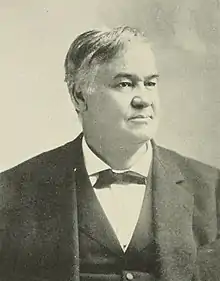William Lindsay (Kentucky politician)
William Lindsay (September 4, 1835 – October 15, 1909) was a Democratic U.S. Senator from Kentucky from 1893 to 1901.
William Lindsay | |
|---|---|
 | |
| United States Senator from Kentucky | |
| In office February 15, 1893 – March 4, 1901 | |
| Preceded by | John G. Carlisle |
| Succeeded by | Joseph C.S. Blackburn |
| Member of the Kentucky Senate | |
| In office 1867–1870 | |
| Personal details | |
| Born | September 4, 1835 Lexington, Virginia |
| Died | October 15, 1909 (aged 74) Frankfort, Kentucky |
| Resting place | Frankfort Cemetery |
| Political party | Democratic |
| Signature | |
Born near Lexington, Virginia, Lindsay attended the common schools and settled in Clinton, Kentucky in 1854. There he taught school and studied law. He was admitted to the bar and commenced practice in Clinton in 1858. During the American Civil War, Lindsay served in the infantry in the Confederate States Army from July 1861 until May 1865, rising to the rank of captain, and serving on the staffs of General Buford and General Lyon. He was released as prisoner of war in 1865 and returned to Clinton to practice law.[1]
Linsay was a member of the Kentucky Senate from 1867 to 1870 during which he supported women's suffrage in the Assembly.[2] He served as judge of the Kentucky Court of Appeals from 1870 to 1878, and served as chief justice of the court from 1876 to 1878. He then resumed the practice of law in Frankfort, Kentucky. He again joined the Kentucky Senate, serving from 1889 to 1893. He then served as United States Commissioner to the World's Columbian Exposition, held at Chicago, Illinois, in 1893.[3]
Lindsay was elected to the United States Senate to fill the vacancy created by the resignation of John G. Carlisle. He was reelected, and served in total from February 15, 1893, until March 3, 1901, and chaired the Committee on Indian Depredations and the Committee on Revolutionary Claims. He was not a candidate for renomination in 1900, but instead moved to New York City and practiced law. He was appointed United States Commissioner to the Louisiana Purchase Exposition at St. Louis, Missouri, in 1901. He died in Frankfort, and was interred in the State Cemetery.
References
- Hatter, Russell; Burch, Gene (2002). A Walking Tour of Historic Frankfort. Gene Burch. p. 36. ISBN 0-9637008-3-9. Retrieved 2008-08-18.
- Anthony, Susan B. (1902). Anthony, Susan B.; Harper, Ida Husted (eds.). The History of Woman Suffrage. Vol. 4. Indianapolis: The Hollenbeck Press. p. 668.
- Campbell, James B. (1894). Campbell's Illustrated History of the World's Columbian Exposition. Chicago: James B. Campbell. p. 155.
- United States Congress. "William Lindsay (id: L000327)". Biographical Directory of the United States Congress.
- Dictionary of American Biography; Schlup, Leonard. "William Lindsay and the 1896 Party Crisis." Register of the Kentucky Historical Society 66 (January 1978): 22-23.
Further reading
- Johnson, E. Polk (1912). A History of Kentucky and Kentuckians: The Leaders and Representative Men in Commerce, Industry and Modern Activities. Lewis Publishing Company. pp. 683–685. Retrieved 2008-11-10.
- McAfee, John J. (1886). Kentucky politicians : sketches of representative Corncrackers and other miscellany. Louisville, Kentucky: Press of the Courier-Journal job printing company. pp. 109–112.
